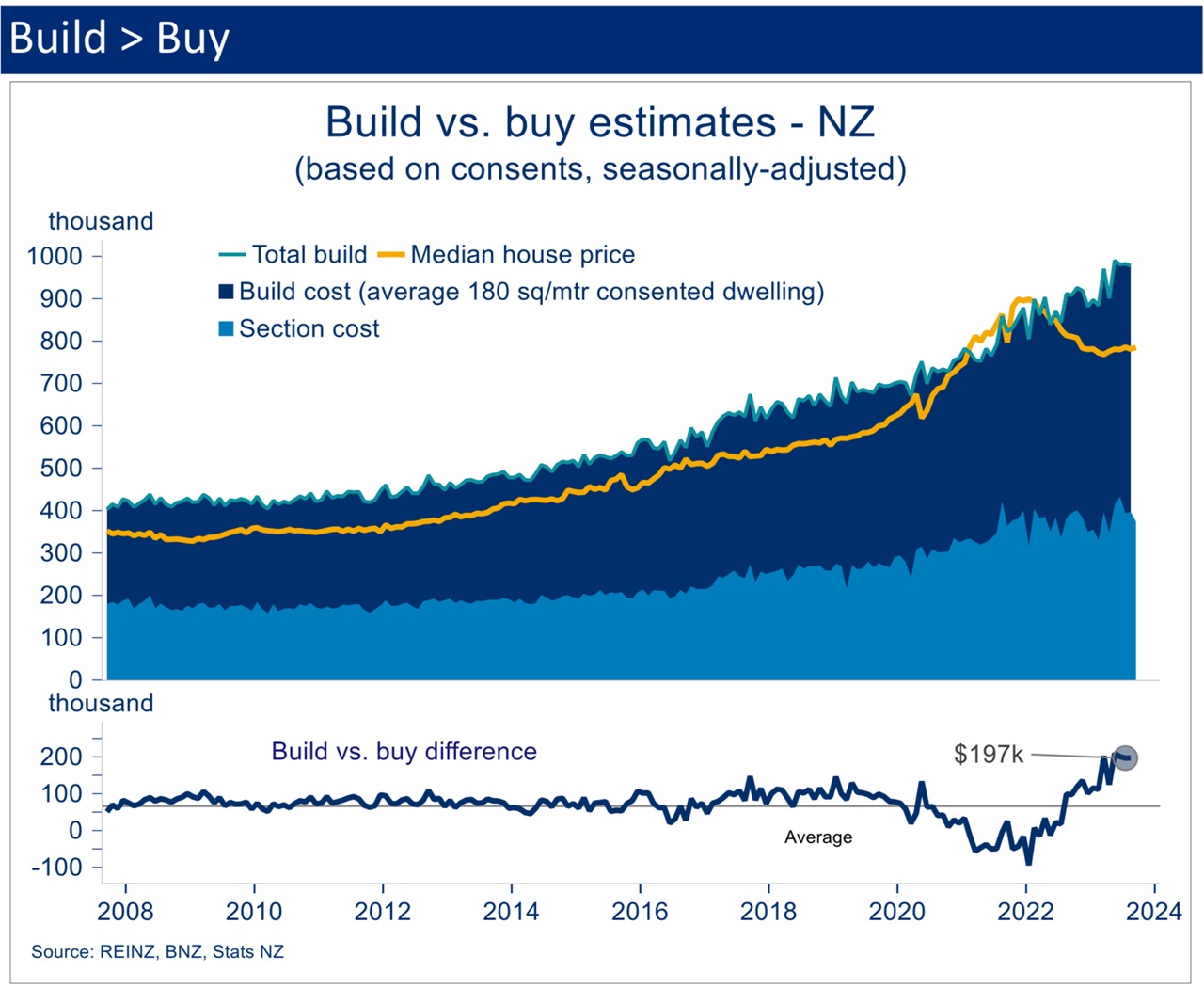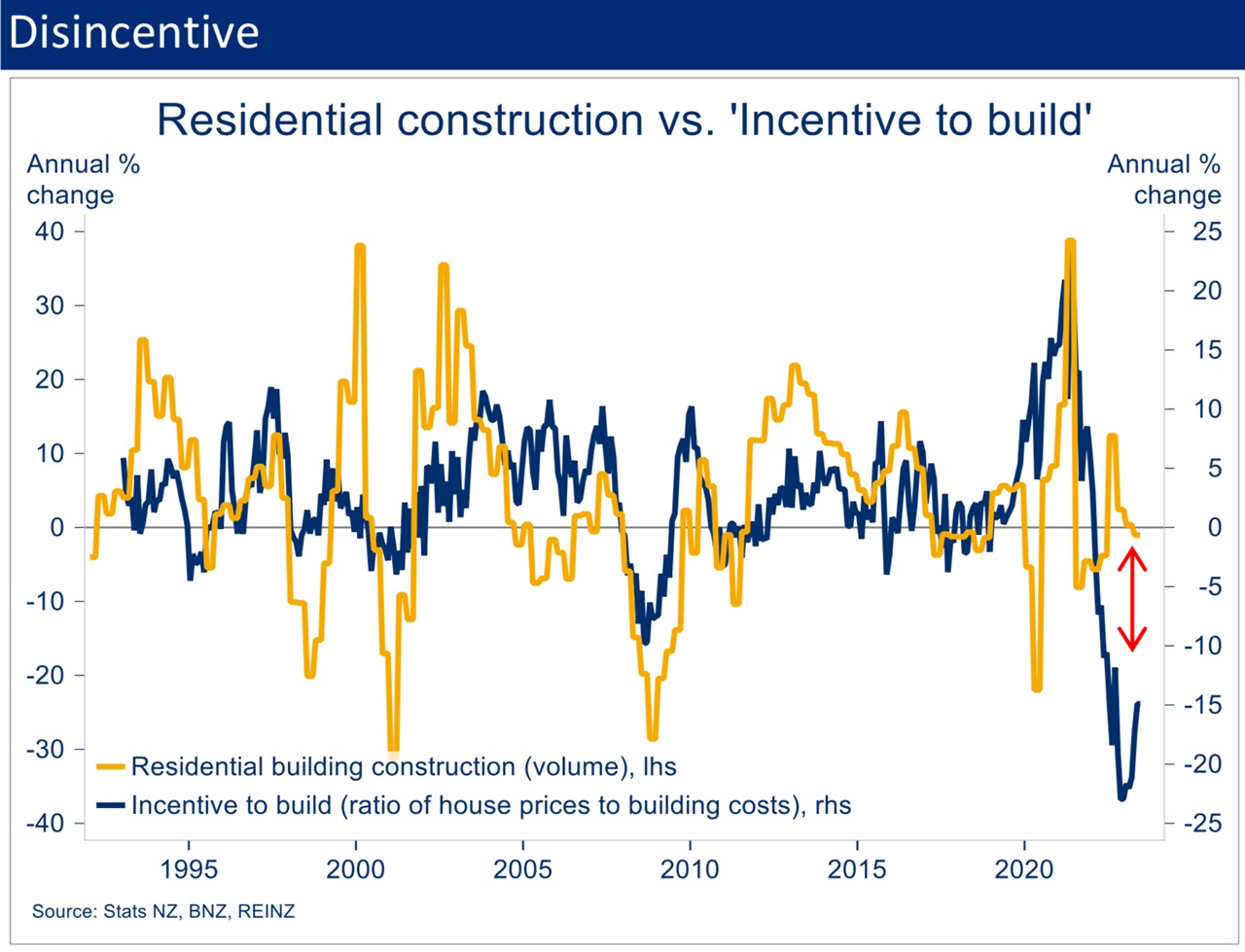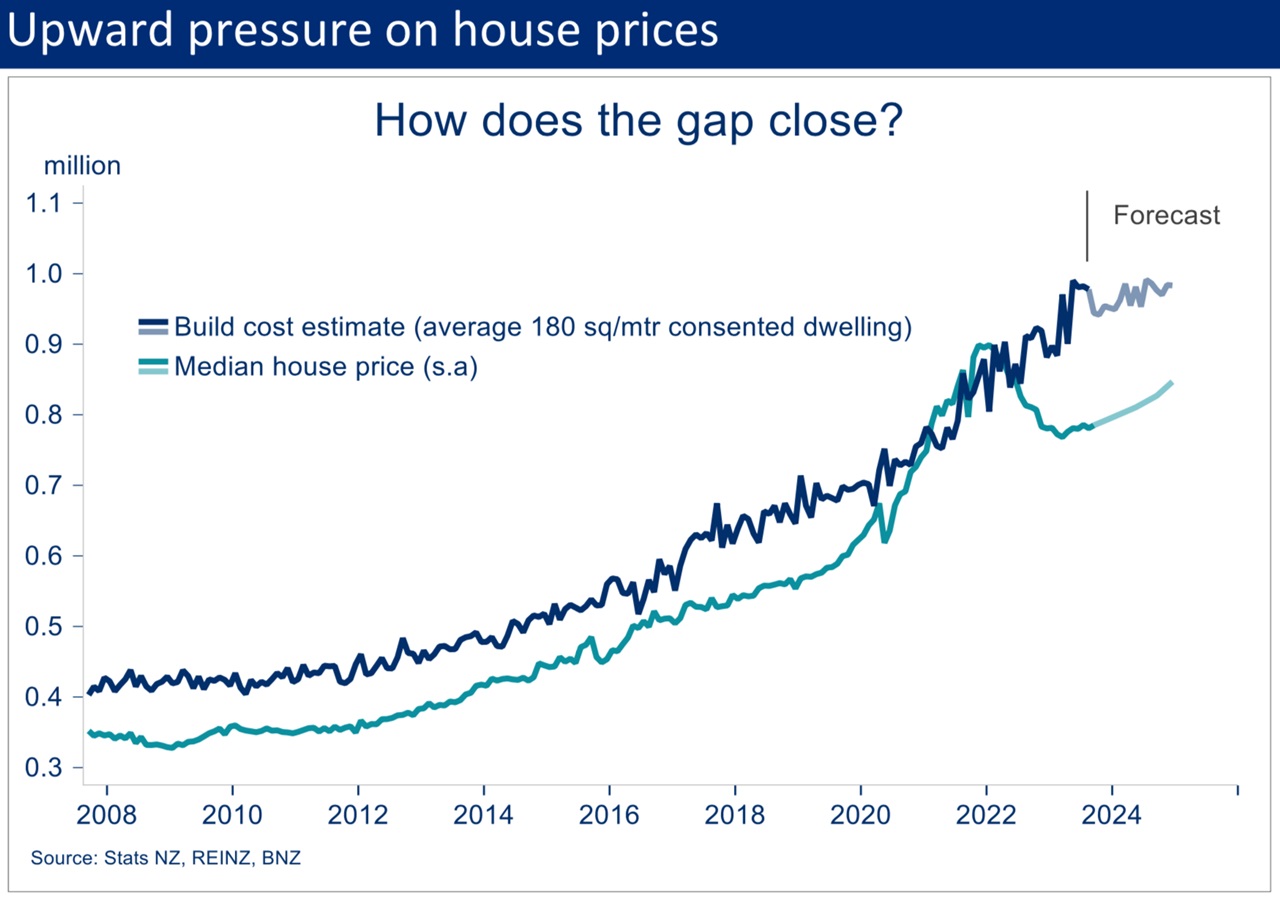
The gap in cost between building a new home and buying an existing one "has never been higher", BNZ chief economist Mike Jones says.
In his latest EcoPulse publication, Jones has done some number crunching and estimates that currently an average new 180 sq m house will cost around $200,000 more than an existing one.
He says with inbound migration soaring and therefore a future need for more housing at a time when construction activity is starting to drop off, the cost gap between new and existing houses will narrow - but that will largely come from higher house prices.
BNZ economists are forecasting that the "tentative upswing" in house prices will gather pace next year with a 7% lift in national house prices through calendar 2024.
"...It’s more expensive to build. It nearly always is. Our analysis puts the average ‘new build premium’ over existing going back to 1995 at about $65k," Jones says.
"Still, there’s no getting around the sheer size of the current premium. The almost $200k difference between building and buying is around the widest ever on our numbers, and about three times the long-run average.
"These numbers are of course indicative, they’re averages, and they vary by region. But they’re strongly consistent with the anecdote and feedback we’re getting around the traps."

In his calculations, Jones has combined average building costs with the median cost of a section.
In terms of the size of house, Jones opted for 180 sq m, which is the post-2000 average.
"If we didn’t do this, build costs would be artificially ‘cheap’ compared to buying an existing house given the declining average size of new builds relative to existing homes.
"Doing all this produces a cost to build estimate for an average residential dwelling of about $980k. That’s made up of a near $400k section cost and a $580k build cost.
"That compares to the median sale price of existing houses of $785k (REINZ data). The latter of course remains well down on the almost $900k peak of late 2021."
Jones says to the extent these figures are representative of the decision facing the average punter, "the general incentive to build rather than buy is very low".
"Writ-large, these cost incentives matter. Witness the chart below in which we’ve mapped the ratio of house prices to building costs – essentially an ‘incentive to build’ proxy – against residential construction. There’s a tight relationship."

Elevated construction costs, lower house prices, and high interest rates are all currently "conspiring against building activity", Jones says and he says it is "no wonder" that new building consent issuance has been in steady decline over the past two years.
He also notes that any existing incentive to build arising from the new build carve out from the 2021 removal of mortgage interest deductibility may soon depart.
"The incoming government intends to progressively restore deductibility to all properties. All of this is potentially problematic in the current environment."
Jones says we are in the midst of a migration-fuelled population boom. There's additional pressure on housing resources "as can be seen in rents".
"If cost issues are disincentivising the building of new dwellings relative to existing homes, it raises the odds we again end up underbuilding relative to the population’s needs.
"The implication is additional upward pressure on house prices as this extra housing demand finds its way relatively more into the existing home market.
"This is essentially what we are forecasting."
The currently wide gap in costs between building and buying should narrow, Jones says.
"The breakneck pace of construction cost inflation is flattening off, and we expect this to continue. But, as the chart [below] shows, this flattening doesn’t do much of the work in closing the build vs. buy gap. More of it is expected to come via higher house prices.

77 Comments
It's really NOT telling you that. Look at the graph - it shows larger escalation for the build cost than the land cost. So, the relative land part of the overall cost has been declining, meaning the main contributing part is the cost of the build itself (including permits, etc.).
Well actually land prices are valued by the difference between house prices and build costs. Land prices should have fallen as building costs went up. But culturally we are so used to land prices relentlessly rising, the concept that land prices should fall is a shock
The answer should be, make more land available, a glut of anything ensures lower prices. I think the gnats understand this basic principle, but no councils especially those run by Greens seem to. Its against Green policy, their aim is restrict restrict restrict but that only pushes house prices and land prices UP
Then when prices are elevated (point B), the prices don't ever retreat back to where they started, point A
All this is telling me is that BNZ is incorrectly defining a dwelling as a "180sqm house on an median sized section".
Now why would they do that? See my comment further down. (You've clearly been suckered by their logic. But don't worry. You'll be in good company.)
We need more South Asian migrant workers to pay for these astronomical costs. As silly as it sounds, that appears to be the thinking of the ruling elite, the bureaucrats, and our 'clever people' at the management consulting firms and in our universities. Similar thinking in Aussie.
If anything is crashing, it's our exceptionalism.
I am not sure if I agree with some of his analysis.
In particular, even though he says house sizes are reducing on average, 180 sq m is still much larger than many detached homes built in the past, especially pre 2000. If I recall correctly, averages in the 50s and 60s were around 80-100 sq m, and then through the 70s, 80s and 90s around the 130-150 sq m mark. Perhaps the sizes blew out a bit in the 2000s, yet the vast majority of our housing stock was built between 1950-2000.
I have a single storey house 155m2 with a detached large single garage of 31m2. Quite adequate for a family of 5 to 6. Anything above 200m2 is a mansion requiring a 500m2 section for 40% coverage, the maximum in my council area. 200m2 will sit quite comfortably on 400m2 section but the council rule will have to change without having to get permission from neighbours. A mansion tax is needed.
Yes the classic 800-1000m2 section with 180-220m2 house in Nelson area is coming slowly but surely to a close as many have been and continue to be split and built on over the decades. Still plenty of 50's-70's around in certain areas though. Perfect to have a garden, orchard or different fruit trees, garage, privacy, and options to get creative with.
No its not, the quality is different, sure you get insulation, and double glazing but try build it on a raised foundations, copper pipes, solid wood floors, eaves for leak protection, wooden cladding and then see the cost.
While the houses will be warmer at the but we are still building as cheaply as possible, within the current building standards, and as those building materials degrade they will be much harder to maintain.
Horses for courses.
If the land is close to amenities and will appreciate quickly, and therefore justify being knocked down and something much larger built where it stands ... all within the next 50-75 years ... Why build them to last longer?
On a lifestyle section or on a section where high densities will never be feasible, different story.
Horses for courses.
This analysis feels a little strange - to start with they are using a 180sqm new build and comparing it to an existing median house price of 785K.
Happy to be corrected on this - but I would imagine the median house (that the $785K is based on) would be approximately 120 sqm and a 3 bedroom and 1 bathroom house whereas a new build of 180sqm would be a minimum 3 bedroom and 2 bathroom house but more likely to be a 4 bedroom and 2 bathroom house.
Now if you look at an existing 3 bedroom, 2 bathroom house most are around the 150sqm mark and I'd estimate the median price of a 3 and 2 would sell for at least 100K higher than $785K, I would also estimate any existing 4 and 2 180sqm house sale price would be close to $1 Million.
As said happy to be corrected but this doesnt feel to be a very good apples to apples comparison.
So long as they have used the 180m2 build cost for the entire series its useful data. Look at the graph, back in 2012 the build cost was circa 1.0x the land cost, now its up at 1.5x the land cost.
And as the author points out, the median house price represents a declining house size as all the newer developments full of townhouses jammed in cheek to jowl have entered the market. If you controlled for the size of the houses that figure would also be higher.
Is not coincidence that history repeats its self..over and over generation after generation
Back in early 70s, same shortage, same inflation, same building, same existing houses far cheaper than even cheap builds.
And same houses 2x in price every 10yrs.. WHEN measured at the 'correction' short period after big price increases. My actual data only goes back to 1940s. A couple world wars and major depression changes to 10yrs, slightly.
All so predictable, so simple, yet so unscientific, or is it?
The graph in this article shows the house building crash, 1975-1980:
https://www.interest.co.nz/property/103227/stats-nz-reports-27-lift-mon…
Note also the big slump 2005-2010.
I struggle to see how we will avoid a similar slump this time, with many of the same factors at play.
Sounds like the return of interest deductibility to existing homes planned by National will be the nail in the coffin to construction of new rentals. Given this premium and without favourable tax treatment, why would a property investor build new instead of buying up existing stock?
Good point. Especially when for a similar price an investor will often be able to buy an existing house with a bit of land (even if it’s only 500 sq m) , compared to a townhouse with a postage stamp of a section (noting the house with a bit of land would typically be in a less desirable location). Obviously the bulk of capital gains are usually in the land….
Whats the average cost per brick? To calculate the cost of each brick, we can divide the average four bedroom house price in New Zealand by the average number of bricks per house.
According to the New Zealand Government, the average price of a four bedroom house in New Zealand in the third quarter of 2023 was $1,132,000. The average number of bricks per house in New Zealand is approximately 10,000.
Therefore, the cost of each brick would be:
$1,132,000 / 10,000 bricks = $113.20 per brick
This means that each brick in an average four bedroom house in New Zealand would cost approximately $113.20.
Bricks can be bought new wholesale for well under a dollar.
100X cost model to RRP. Nice work if you can get it, building sector.
Right, but is any other component of a house worth 100x more than a brick, kilo for kilo? My point is that by any measure including some of the cheapest components they are made from, the cost of houses and the cost of construction of houses far exceeds their economic value by an astonishing multiple.
As I said the other day, I don't think you can bring one of those existing homes up to scratch for less than $200k (unless you DIY). In a lot of cases the majority of the house is close to or past its useful lifespan - roof, weatherboard, plumbing, joinery, electrics, piles, asbestos, etc. And after you replace that you are still left with a small single bathroom single glazed uninsulated home.
I accept the following:
1. Land prices will continue to go up in real terms. (Nobody is making any more of it.) It will rise more quickly in desirable areas and developable areas. And will be landbanked to create scarcity until we get wise enough to vote for a government that taxes this selfish behavior.
2. Construction costs will - over the medium to long term - stay about the same in real terms. (These swing around wildly but history shows, on a like for like basis, construction costs haven't changed much in real terms.)
3. That Councils and Territorial Authority costs will remain wildly unpredictable and pernicious until the pearl clutchers have been driven from their premises and fellow pearl clutchers stop voting for ignorant politicians to represent their wildly outdated views.
Wrong.
Slave labor is a tiny part of the equation.
The major part of the equation is that significant capital investment is required to set up an efficient and therefore profitable milling operation.
And further, most millers do a whole heap more than just cut the wood, e.g. glulams (glue laminates like CLT) with computer controlled cutting directly off digital plans for on-site assembly.
NZ's stupid tax laws make it far more profitable to buy the land on which such a plant could be put and then reap the tax-free capital gains than actually take the risk of actually building something productive that would benefit NZ Inc. (And I'll not add in all the pernicious extra costs Councils and TA's would impose.)
So ... Who'd you vote for? A party looking to change our dreadful tax system? Or one that is preserving the status quo for existing property owners?
It gets even worse ....
You probably know we can build 6-8 storey buildings in structural timber nowadays. They cost a bit more but go up really fast. I mean really fast thereby cutting the costs of working capital. And where does this pre-cut mass timber come from? Australia! NZ's capacity is far, far behind.
And it's far, far lighter which means less concrete under the ground to support the building.
Did you know banks don't like it?
They like the slow traditional methods using steel or concrete as it maximises their interest bills (and therefore profits) by having working capital tied up for longer. The banks also claim that glulam building are riskier so even if you get the working capital they still hamstring the 6 to 8 storey build using wood.
But, imagine how much greater our (i.e., taxpayer) costs would be to the accommodation supplement and WFF had there not been the minimum wage rises.
Cost of living is just generally too high here (as pointed out in another article - we are the last bus stop on the planet) for a low wage economy.
It really boils down to either:
a) more government assistance with cost of living, or
b) more government intervention in the labour market by way of minimum wage increases (and/or meeting the pay demands of the public service for wage increases).
We're just too remote to be viable :-) but I wouldn't live anywhere else!
Cost of living only really feels high because the cost of shelter is so high - which is a direct result of government action/inaction [take your pick].
I have no idea how the lower echelons make ends meet - I can only surmise prevalent overcrowding to mitigate this cost.
Define "house", BNZ. Oh, you did. ... 180sqm on a median section.
The definition changes all the time. But our individual cognitive biases do not. The older you are the more likely the definition is akin to what you are used too. Think about that for a minute. Spare me the hand wringing and pearl clutching. Think about it for longer.
Don't worry. We'll get used to living in smaller 'houses', on vastly smaller pieces of land. Nothing new here. And nothing bad. The bulk of the population live in cities and people in cities value the location and surrounding amenities more highly than the 'house' size, or how far above ground level it is, or how much ground comes with it.
If everything remains the same BNZ might be right. And were BNZ to define "house" correctly by dividing it into the different types correctly, their prediction might be right for the one type of 'house' they suggest is representative (but isn't anymore as our NZ cities grow larger).
In the absences of real world analysis, BNZ's view looks to me to be nothing but a marketing tactic to drive those who might be thinking of buying into a state of advanced FOMO to kickstart the next housing market stupidity.
(Oh, and yeah, and increase bank profits. Have I mentioned that bank economists' predictions should be treated with much circumspection?)
edited: "Elevated construction costs, lower house prices, and high interest rates are all currently "conspiring against building activity", Jones says and he says it is "no wonder" that new building consent issuance has been in steady decline over the past two years." ... Seriously? It's all about building costs, huh? And RBNZ actions aren't by far and away the major cause?
Also depends on the type of materials used and the quality of the builders. Remember the 1980's leaking house crisis?
You can get a house built by asian immigrants, or you can get a quality build, constructed by real kiwi carpenters, something like a weatherboard villa.
But it's gonna cost you.


We welcome your comments below. If you are not already registered, please register to comment.
Remember we welcome robust, respectful and insightful debate. We don't welcome abusive or defamatory comments and will de-register those repeatedly making such comments. Our current comment policy is here.